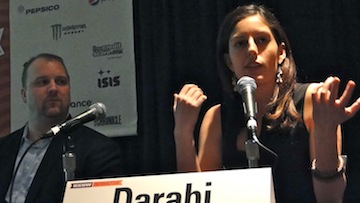SXSW Report: TV and Mobile Screen Convergence
The audience led the way in a full-to-capacity day three South by Southwest Interactive panel on the convergence of television and social media. While the panelists were strong at describing where we are today, the SXSW crowd wanted to know where we're going next.
The the industry is seeing growth in cord-shaving and cord-cutting, noted moderator Chris Perry, president of digital for Weber Shandwick, but traditional TV isn't going away anytime soon. Rather, content publishers are looking for more ways to integrate multiscreen distribution in what they offer.
Second-screen experiences, where viewers watch broadcast content on their TV while also enjoying contextual information (including social network feeds) on a tablet, are paying off for broadcasters. Fred Harner, general manager for SportsNet New York, noted that companies that offered second-screen experiences enjoyed big spikes in both usage and time spent with both the program and the tablet page.
Second-screen content can even deliver more entertainment value than the program it's supporting. That was the case for Soraya Darabi, co-founder of Foodspotting, who said that social networking helped her get through this year's dull Academy Awards ceremony.
 "At some point I was looking at my iPad the whole time, rather than my TV," Darabi said.
"At some point I was looking at my iPad the whole time, rather than my TV," Darabi said.
But what's coming next?, asked the tech-forward SXSW audience. Asked if there's a "bad guy" in the mix, holding up the move to online distribution, Eric Bruno, senior vice president of consumer product management at Verizon Wireless, said that there wasn't a bad guy but a "scared guy." Hollywood is cautious and people are just now sticking their toe in the water. Happily, they're liking what they find and audiences will enjoy more convergence over time.
"The lake just keeps getting bigger," said Bruno. "By the way, we're scared, too."
Asked by the audience about the biggest emerging technology on the horizon, Darabi said she was excited about possibilities in sentiment analysis based on location. That allows companies to research how viewers in different continents think differently about the same content.
One audience member wanted to know if publishers were concerned about getting too far in front of the convergence trend, offering high-tech options that the average audience isn't ready for yet. Harner noted that social network feed can be overwhelming, and that companies trying to inform and engage the viewer can offer them too much content. In the same way, companies can err in being too cutting-edge with features.
"It's real easy to get caught up in this fast paced environment where everything's happening quickly and you feel like you have to be in there." Harner said.
Content companies need to be on the edge, noted Bruno, but not so close to the edge that they fall off.